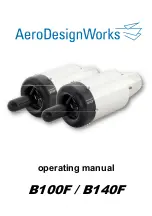
operating manual B100F / B140F 2019-06-27
4
Maximum speeds under jet propulsion can exceed 400 km/h, depending
on the model.
The resulting loads effect the whole structure, not only the rudders or the
installation of the servo wires.
Models have to be constructed with jet aircraft specific stability. Please ask
manufacturers about the current level of production standards for the
models in question. Meanwhile, a large array of models built for jet
propulsion is available by different manufacturers. Servos should be at
least 1.5 times stronger than for comparable models with conventional
engines.
During installation, seal the intake and nozzle, as well as propane and
kerosene joints to keep dust and debris out of the engine.
Really make sure to:
first inform, then buy
have the fitting size model for your turbine
select servos that are powerful enough
construct servo wiring and rudder joints very carefully and
reinforced
seal the turbine during the installation process
1.3. Before starting the engine
Tank system, pump, shut-off kerosene valves and turbine must
be checked for correct alignments.
Loose parts in the intake area must be fixed in a way they can
never be sucked in. Loose parts or dirt can damage or destroy
the turbine. We recommend the use of a protection screen.
Have a fire extinguisher (CO2) within reach!
The kerosene system must not be leaking.
Use only kerosene or Diesel with a 5% fraction of lubrication
(fully syntethic 2-stroke mix oil or turbine oil).
Take off must be against the wind.
Hold the turbine with the nozzle facing downwards right before
take off so excess fuel can run off to avoid a hot start of the
engine.




















